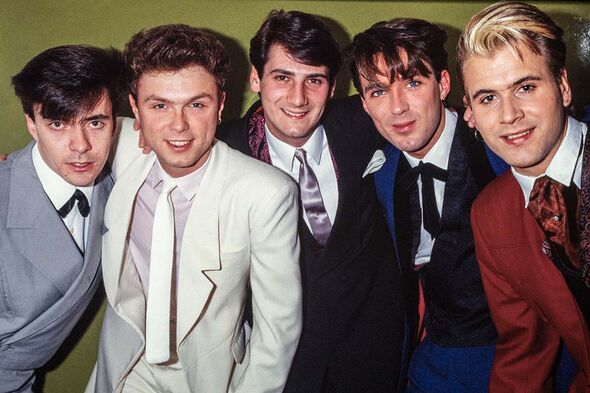Origins of the Term “Spandau Ballet”
Historical Context
The term “Spandau Ballet” has two primary interpretations, both rooted in historical events:
- Spandau Prison: Located in Berlin, Spandau Prison was used to detain Nazi war criminals after World War II. The prison became notorious for housing figures such as Rudolf Hess, who was sentenced to life imprisonment. The term “ballet” in this context refers to the grotesque movements of prisoners during executions, which some sources describe as a “dance.” This interpretation evokes a dark imagery associated with the final moments of condemned individuals.
- Spandau Machine Gun: Another interpretation links the term to the German MG08 machine gun, known as the Spandau, which was used during World War I and II. The phrase “Spandau Ballet” is said to describe the erratic movements of soldiers hit by gunfire, particularly those caught in barbed wire. This usage highlights the violent and tragic consequences of war, where the term evokes the image of soldiers’ bodies jerking in their last moments.
The Band’s Adoption of the Name
Spandau Ballet, the band, was formed in London in 1979, emerging from the post-punk underground dance scene. The name was reportedly inspired by graffiti that band member Gary Kemp saw on a wall in Berlin, which read: “Rudolf Hess, all alone, dancing the Spandau Ballet.” This graffiti referenced Hess’s imprisonment and the dark history associated with Spandau Prison. The band chose the name for its evocative imagery and unique sound, which helped them stand out in the music scene.
The Band’s Journey and Musical Impact
Formation and Early Years
Spandau Ballet was formed by Gary Kemp, Martin Kemp, Tony Hadley, Steve Norman, and John Keeble. The band quickly gained popularity with their distinctive blend of new wave and pop music, becoming a prominent figure in the New Romantic movement. Their debut single, “To Cut a Long Story Short,” reached the top five in the UK charts in 1980, marking the beginning of their success.
Major Hits and Albums
Spandau Ballet’s most famous song, “True,” released in 1983, became a massive hit, reaching No. 1 in the UK and the top five in the US. The song’s smooth melodies and heartfelt lyrics captured the essence of the era, solidifying the band’s place in pop history. Over the years, they released several successful albums, including:
- Journeys to Glory (1981)
- Diamond (1982)
- True (1983)
- Through the Barricades (1986)
The band sold over 25 million albums worldwide and had numerous hit singles, making them one of the most successful bands of the 1980s.
Legacy and Reunion
After disbanding in the early 1990s, Spandau Ballet reunited in 2009 for a successful world tour. Their music continues to resonate with fans, and they remain a significant influence on contemporary pop and new wave artists.
The Dual Meaning of “Spandau Ballet”
The dual interpretations of “Spandau Ballet” serve as a reminder of the complex relationship between art and history. While the band has embraced the name for its catchy and memorable quality, the historical implications cannot be ignored. The juxtaposition of a pop band with a name rooted in violence and tragedy raises questions about the appropriateness of such a choice.
Cultural Reflections
- Art vs. History: The use of a name associated with dark historical events in a pop music context highlights the tension between cultural expression and historical memory. It prompts discussions about how artists navigate their influences and the meanings behind their work.
- Public Perception: The public’s reaction to the name “Spandau Ballet” has evolved over the years. Initially, many fans were unaware of its historical connotations, but as the band’s fame grew, so did the scrutiny of their name. This has led to varying interpretations and discussions about the appropriateness of the name in light of its origins.
- Legacy of the Band: Despite the controversial origins of their name, Spandau Ballet’s music has transcended its historical roots. The band’s legacy lies in their contributions to the music industry and their ability to connect with audiences worldwide.
Summary Table
| Aspect | Details |
|---|---|
| Name Origin | “Spandau Ballet” refers to movements associated with executions at Spandau Prison and gunfire. |
| Band Formation | Formed in 1979 in London, part of the New Romantic movement. |
| Major Hits | “True,” “Gold,” “Only When You Leave,” among others. |
| Album Sales | Over 25 million albums sold worldwide. |
| Cultural Impact | Influenced the pop and new wave genres; discussions about the name’s historical implications. |
FAQ Section
Q1: What does “Spandau Ballet” mean?
“Spandau Ballet” has two primary meanings: it refers to the erratic movements of prisoners during executions at Spandau Prison and the behavior of soldiers hit by the Spandau machine gun during warfare.
Q2: Why did the band choose the name “Spandau Ballet”?
The band adopted the name from graffiti they saw in Berlin, which referenced Rudolf Hess and the dark history associated with Spandau Prison.
Q3: What are some of Spandau Ballet’s most famous songs?
Some of their most famous songs include “True,” “Gold,” and “Only When You Leave.”
Q4: When did Spandau Ballet form?
Spandau Ballet was formed in 1979 in Islington, London.
Q5: How successful was Spandau Ballet?
The band sold over 25 million albums worldwide and had numerous hit singles, making them one of the most successful bands of the 1980s.
Q6: Has Spandau Ballet reunited?
Yes, Spandau Ballet reunited in 2009 for a world tour and continues to perform.
Q7: What impact did Spandau Ballet have on music?
Spandau Ballet was influential in the new wave and pop music scenes of the 1980s, shaping the sound of the era.
Q8: Are there any controversies surrounding the name “Spandau Ballet”?
Yes, the name’s historical implications have sparked discussions about its appropriateness, given its association with violence and tragedy.
Conclusion
The term “Spandau Ballet” encapsulates a rich tapestry of historical significance and cultural impact. While the name originated from dark events, it has been transformed by the music of the band into something that resonates with audiences worldwide. The dual meanings serve as a reminder of the complexities of art, history, and public perception. As Spandau Ballet continues to be celebrated for their contributions to music, the conversations surrounding their name will likely persist, reflecting the intricate relationship between cultural expression and historical memory.For further information on Spandau Ballet, you can refer to the Wikipedia page on Spandau Ballet.This article provides an in-depth exploration of the meaning of “Spandau Ballet,” its historical context, and the legacy of the band.



